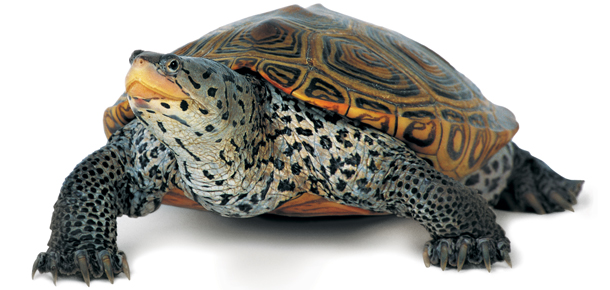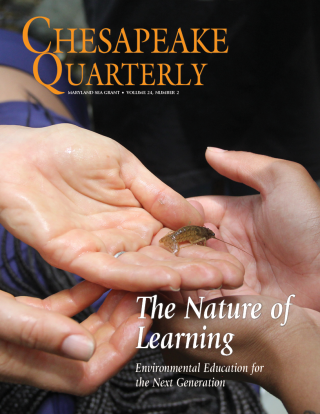Knauss legislative fellowships in Congress help build careers — and they're fun and educational. See our video and fact sheet for details.
The Maryland Sea Grant Bookstore will be closed for the winter holidays from Monday, December 15th to Friday, January 2nd and will not be taking orders during that time.
Diamondback Terrapins

The diamondback terrapin (Malaclemys terrapin) is the official state reptile of Maryland and the mascot of the University of Maryland, College Park. Here are some facts about this important reptile and symbol.
- The diamondback terrapin lives in estuaries and bays from Cape Cod south to Texas.
- Males can grow up to six inches long, while the usually bigger females can reach nine inches.
- Terrapins primarily eat mollusks such as snails, clams, and mussels. Their strong, sharp beaks allow them to break their prey’s hard shells.
- Though terrapins can live longer than forty years, fewer than 20 percent of eggs laid actually survive the first year. Predators such as foxes, raccoons, and skunks prey on eggs and juveniles.
- Markings on the carapace, or shell, of the diamondback terrapin are as unique as a human’s fingerprints, allowing scientists to identify them by sight.
Despite their cultural status in Maryland, populations of terrapins in the state face significant threats today.
- Shorefront development has damaged or replaced many of the beaches where terrapins lay their eggs.
- Many terrapins become caught in lost crab pots or traps that are being actively fished.
- Terrapins are killed on land while crossing roads and in aquatic habitats by passing boats.
- Responding to a growing demand for turtle meat in Asia, Marylanders harvested terrapins for food for many years. In 2004 roughly 14,500 pounds of terrapins were harvested throughout the state. The practice was banned by the Maryland state legislature in 2007.
Learn more
Chesapeake Quarterly Article: To find out more about research funded by Maryland Sea Grant about diamondback terrapins, see Terrapins: The Fall & Rise, an issue of Chesapeake Quarterly, Maryland Sea Grant's magazine.
Maryland Sea Grant Video: "Boom Times for the Terrapins of Poplar Island"
Photograph by John Consoli





